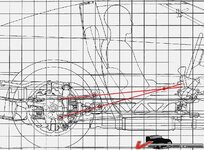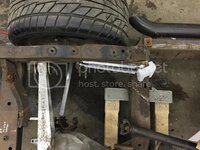voodoovette
Well-known member
Thanks to both STINGXRAY and STROKER-427, I appreciate your time and help very much, thanks again:yahoo:
Think i got it wrong, meant Stroker-427-6 link!.Wow, you guys are incredible, way over my league!,really want to do this mod but dont have talent to fabricate and weld all thoose parts together.
Is there anyone who have one or can build me a complete giovanni 6-link set-up?.
Thanks...
There are a lot of smart guys on this forum, so stand by for their thoughts.
Pappy
There are a lot of smart guys on this forum, so stand by for their thoughts.
Pappy
I will absolutely do, thank you for your explanation.
I was struggeling with the idea that the forward control arm can somehow be the only connection to withstand the braking force but could not quite visualize it properly.
Although i have a technical background i found out the subject of suspension is so widely expanded i can probably read and learn for a year and still not know everything.
That is probably what makes it so interesting..
Can you change that much to the suspension in The Netherlands ? Over here you can have a serious issue with tech inspection.
LOL, the welds on an original frame would be considered an amateur hack job from today's standards.It's crappy and amateuristic work that attracts the wrong kind of attention from an inspector. If the work looks OK and is of good quality it will pass because the inspector assumes it is original. You don't want to give hime a reason to investigate deeper....
LOL, the welds on an original frame would be considered an amateur hack job from today's standards.
Hi guys,
I am following this topic with more than average interest because i started a major body-off restomod of my '80 4 speed and would like to do some severe frame and suspension modifications, but looking at this six-link setup something seems to be not covered in this topic (or any other topic i read about the six link setup)
Can you guys help me out with my thoughts?
In this setup i see a lot of control rods with heim joints, which are proven technology i suppose. The main wheel hub is kept in place by two (upper and lower) control rods sideways, two rods in longitudinal direction replacing the trailing arm and one rod which controls toe.
All these rods were positioned to perform their job in the direction they were laid out, the upper/lower/toe control rods are almost parallel, so far no problem.
But what happens at heavy braking? It seems to me that under severe braking a huge torsional force is applied between the wheel and the caliper which is transferred to the chassis. This torsional force can only be transferred through the parallel upper and lower control rod and the toe control rod, and they are not in a position to cope with this torsional force in the direction they are positioned. (perpendicular to the circumferential braking force). The two longitudinal control rods replacing the trailing arm can do nothing (*) to withstand the braking torque being positioned in the same working plane as the braking torque.
(*) or can they? Do they act as a pulling rod to withstand the braking forces?
Why do the 3 control rods not twist as a pretzel under severe braking? (or perhaps they do but no one noticed?)
This situation occurs only under heavy braking and not under acceleration because slamming the gas does not introduce a heavy torque on the suspension as braking does (i assume because the brake caliper is mounted to the wheel hub). Just imagine a bar stool with 3 legs which are connected with heim joints to the floor and the seat. The floor is the chassis, the seat resembles the wheel and the 3 legs are your control rods. Now try to rotate the seat and imagine what happens with the three legs...
Just trying to understand suspension issues before i choose the setup which works for me, but this issue really botheres me because i am afraid this six link setup will soon starts to develope a lot of slack/slop as a result of the excessive forces on the control rods during braking. This really keeps me from choosing this setup for my car and for now i am considering either a custom offset trailing arm (offset as in moving the bearing hub outside) or maybe a full upper and lower A-arm construction (which is a lot more difficult). I am planning C6/Z06 wheels (19x12") at the rear with an increased track width and widened body.
Thanks for your input, Rene from The Netherlands/Europe

I agree with Pappy !!
The suspension system is like any other component of a sport car...... a short blanket !
Regarding the forces to the longitudinal rods.... the rod-ends are much more strong than necessary.... the forces you are talking about are applyed to the hub via two bolts (the ones holding the caliper).... so don't be afraid of that !!!
I have a question regarding the trailing links in this suspension design. If you were to use the stock length half-shafts as a suspension member (instead of running the top link), are the trailing links parallel to the car centreline in plan view? Or will the trailing links converge towards the centreline?

